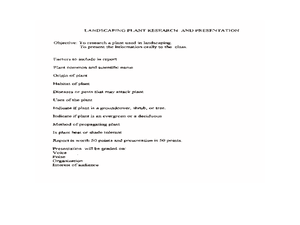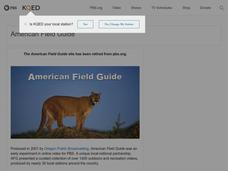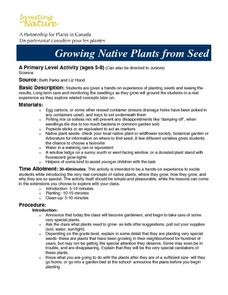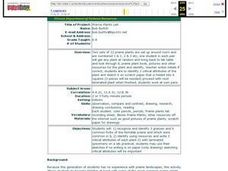Curated OER
Plant Diversity
Here is an all-encompassing overview of the plant kingdom! In this worksheet, beginning botanists describe characteristics of the four different plant phyla, explain various life cycles, differentiate between monocots and dicots, and...
Curated OER
Commonly Confused Words: More Homonyms
Understanding the spelling and meaning of homophones is particularly difficult for English language learners. This online quiz focuses on 20 different sets of homophones. The learner reads the sentence and decides which word fits best.
Curated OER
fun with Plants that We Use
Students become familiar with the products made from various plants. For this plants lesson, students experiment with natural dyes from plants. Students complete a list of things made from plants. Students answer questions about plant...
Reed Novel Studies
Flora and Ulysses: Novel Study
As Flora from Flora and Ulysses drowns in her misery, she discovers a squirrel with bigger problems than her own. She saves him from the vacuum cleaner and finds out that his brush with death gave him superpowers. Scholars match...
Curated OER
Pair the Plants: An Introduction to Scientific Names
Students examine why plants have both common and scientific names, then complete the activity by matching each common plant name with its scientific name. They finish by working in cooperative groups to create an ABC of Plants class book.
Curated OER
Plants, Plants, and More Plants
Students examine several types of plants. In this plant lesson, students complete activities that require them to identify types of plants, chart plant anatomy, and explain plant propagation.
Curated OER
First Nations Plants and their Uses
Students identify the uses of plants by researching Native Americans. In this First Nations culture lesson, students identify the First Nations coastal people of British Columbia and their use of plants such as seaweed, bark and moss....
Curated OER
Flowers and Plants
Students are assigned to bring five flowers. They explore flowers to distinguish different physical features of flowers. They compare and contrast different flowers to determine what features they have in common. Students develop an...
Curated OER
Plants: Scattering Seeds
Students collect and microscopically examine seeds from the school yard and neighborhood. In small groups, they draw and discuss the shapes of the seeds to determine each plant's method of dispersal. they also test two types of seeds...
University of Wisconsin
Bimodel Botany Bouquet
Gardeners are given an individual plant specimen from a bouquet of local rain garden plants. They group up by their plant type and then make observations together, name the plant, and introduce it to the rest of the class. You then share...
US Mint
Desert Dwellers
What can a quarter possibly teach young learners about desert ecosystems? More than you might think. After displaying and discussing the included picture of the Arizona state quarter, the class participates in a series of shared reading...
Curated OER
The Dirt on Plants
Students draw and label the four parts of a plant. They describe changes that are part of the common life cycle. Students follow various one and two step directions. They are asked to discuss that they can recall about plants.
Curated OER
Characteristics of Plants
In this characteristics of plants activity, students name two things that all plants have in common. Then they describe how the cell walls and cuticles help plants adapt to life on land. Students also explain the difference between...
Curated OER
Habitat for Plants! There's No Place Like Home!
Learners compare and contrast conditions necessary for survival of aquatic and terrestrial plants, identify common and scientific names of plants,
and determine correlation between location and plant characteristics. Students then use...
Curated OER
Word Search: Common Seashore Plants
In this science worksheet, students find the names of 15 plant species common to the seashore in a word search puzzle. The word bank has detailed color drawings of each plant.
Curated OER
Word Search: Common Desert Plants
In this science worksheet, learners locate the names of 15 desert plants in a word search puzzle. The word bank has a realistic, detailed color picture for each plant name.
Curated OER
Growing Native Plants From Seed
Second graders plant seeds of native plants. They study the concepts of native plants, where they grow, how they grow, and why they are so special. They assess long term care monitoring the seedlings as they grow and write the name...
Alabama Learning Exchange
What do Plants Need?
Students plant seeds and watch them sprout. Once growing plants are placed in different conditions and students record data about their growth. They graph the data.
Curated OER
Leveled Problem Solving: Least Common Multiple
In this least common multiple practice worksheet, students sharpen their problem solving skills as they solve 6 story problems.
Curated OER
Comparing Animals and Plants Venn Diagram
In this comparing 2 items worksheet, students construct a Venn diagram involving the comparison of animals and plants and what they have in common.
Curated OER
WET Science Lesson #3: Comparison of Aquatic and Terrestrial Plants
Elementary life science explorers compare and contrast aquatic and terrestrial plants (elodea and soybeans) in a Venn diagram. Some background information is provided to support direct instruction, and general instructions are provided...
Curated OER
What Parts of a Plant Do We Eat?
Did you know that tomtoes and cucumbers are actually fruits? Biology or botany beginners read about the function of flowers and fruit and find that some food items commonly called vegetables are, by definition, also fruits! Give learners...
Curated OER
A Hidden Beauty
Expose the beautiful mystery of bulbs as young botanists learn all about these fascinating plants. They glean information from a short text before observing actual bulbs (consider an onion), and comparing their findings with predictions....
Curated OER
Prairie Plants Lab
Learners recognize and identify 3 grasses and 9 common forbs of the fermilab prairie and which were common in IL, identify using resources and write 3 critical attributes of each plant.

























